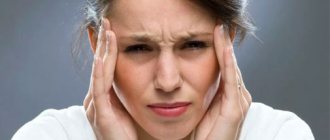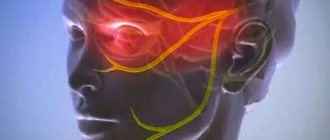Ear pain is a fairly common symptom. Painful sensations in this case give the patient a lot of unpleasant moments, and it is very difficult to simply “endure” such pain. It is noteworthy that pain in the ear is not always associated with diseases of the hearing organ. Such painful sensations can also be caused by other organs that radiate, that is, “giving off,” to the ear. A condition in which the ear hurts, but there is no inflammation in it, is called otalgia.
Otalgia can be caused by many reasons:
Temporal arteritis
The disease is an inflammation of the vessels of the temporal artery.
If the inflammatory process spreads to the ear artery, the patient will also experience pain in the ears. This disease is typical for older women. It causes blurred vision, headaches, pain in the temples, and increased fatigue. Make an appointment right now! Call us by phone or use the feedback form
Sign up
Along the branches of the vagus nerve, pain can radiate to the ear from the esophagus, thyroid gland, and organs of the cardiovascular system.
If you have ear pain, you should definitely consult with an otolaryngologist, since this condition may signal the presence of serious diseases in the body. If the ear is healthy, no abnormalities have been identified, and the pain does not go away, it is necessary to diagnose the nose, larynx, pharynx and, if necessary, other organs to identify the cause of otalgia. Further treatment will depend on the diagnosis.
What does a headache behind the ear mean? Causes, symptoms and treatment
Although headaches are common, pain behind the ear is uncommon. This type can have several causes, from nerve damage to dental problems. The symptoms and further treatment will depend on the cause of the headache. We'll look at the signs and symptoms of headaches behind the ear, what causes them and how to get rid of them. Causes of Headaches Behind the Ear
There are several possible causes of headaches behind the ear. These include:
Occipital neuralgia One of the most common causes of headaches behind the ear is a condition called occipital neuralgia. Occipital neuralgia occurs when the occipital nerve, or the nerves that run from the top of the spinal cord up to the head, become damaged or inflamed. Due to the similarity of symptoms, acute pain behind the ear is often mistaken for migraines or other types of headaches. People who suffer from occipital neuralgia describe the chronic pain as piercing and throbbing. They also compare it to the sensation of an electric shock in the following places:
- Upper neck
- Back of the head
- Behind the ears
Occipital neuralgia occurs as a result of pressure on or irritation of the occipital nerves. It usually appears on only one side of the head. In some cases, pressure or irritation may be caused by inflammation, muscle strain, or injury. Very often, doctors are unable to determine the cause of occipital neuralgia.
Mastoiditis Mastoiditis is an infection of the mastoid bone, which is located directly behind the ear. This infection is much more common in children than in adults and is usually completely cured without leaving any complications. Mastoiditis can cause headaches behind the ear, as well as fever, ear discharge, fatigue, and hearing loss in the affected ear. Temporomandibular joints
The temporomandibular joints (TMJs) are hinges that connect the lower jaw to the base of the skull. These joints, when inflamed, can cause pain. While most people with temporomandibular joint inflammation feel localized pain in the jaw or behind the ear, others may simply experience a headache behind the ear. Inflammation of these joints may be associated with the following factors:
- Stress
- Teeth grinding
- Arthritis
- Injury
- Jaw alignment
Symptoms Symptoms of a headache behind the ear can vary depending on the cause. Occipital neuralgia can cause severe pain in the back of the head or upper neck. It often starts in the neck and rises up to the back of the head. Episodic pain is similar to an electric shock to the back of the head or neck. Signs of infection, such as fever or fatigue, often accompany mastoiditis. In addition to headaches behind the ear, inflammation or injury to the temporomandibular joint can cause tension or pain in the jaw.
- Additional symptoms that people with headaches behind the ear may experience include:
- Pain on one or both sides of the head
- Sensitivity to light
- Burning and throbbing pain
- Pain behind the eyes
- Painful scalp sensations
- Pain when moving the neck
examination for headaches behind the ear
It is extremely important to see a doctor who can make the correct diagnosis and help determine a treatment plan. To make a diagnosis, the doctor must review the patient's medical history, which includes information about any recent injuries to the head, neck, or spine. After this, your doctor will likely perform a physical examination. To do this, he will press on the back of the head and the base of the skull to see if these touches cause pain. Such an examination is necessary to determine occipital neuralgia, since, in most cases, these are the places that are sensitive to touch. You may need an injection to numb the nerve. If after this the person experiences relief, then the cause of the pain is most likely occipital neuralgia. In some cases, your doctor may order an MRI or blood test to further confirm or rule out other causes of pain. If occipital neuralgia has been ruled out as a possible cause of pain at the first visit, the doctor will likely check for signs of mastoiditis, including fever and ear discharge. To make an accurate diagnosis, your doctor may examine your jaw or recommend visiting a dentist to check for TMJ inflammation.
Treatment at home If the root cause of the headache cannot be determined, you should focus on eliminating the symptoms. There are several at-home treatment options that can be used in addition to your doctor's instructions. These home treatments include:
- Relax in a quiet room
- Anti-inflammatory drugs, such as ibuprofen
- Neck muscle massage
- Applying something warm to the back of your neck
- Stress Reduction
- Stopping teeth grinding
As with any treatment options, you should consult your doctor before implementing these recommendations.
Treatment
Physiotherapy is one of the methods of treating headaches behind the ear. Depending on the cause of headaches behind the ear, the doctor may prescribe treatment that includes:
- Prescription muscle relaxants
- Nerve blocks and steroid injections
- Physiotherapy
- Antidepressants
- Antisecretory drugs such as carbamazepine and gabapentin
- Antibiotics for suspected mastoiditis
- Occlusal pins
Nerve blocks and steroid injections are temporary methods and require regular visits to the doctor for repeat injections. In rare cases, surgery may be required. As a rule, operations are prescribed if the pain is not eliminated with the help of other treatment methods or if it constantly reminds itself. Operations that can be prescribed:
- Microvascular decompression. This procedure involves finding and repositioning blood vessels that are compressing the nerves.
- Occipital nerve stimulation. The neurostimulator sends several electrical impulses to the occipital nerves. In this case, electrical impulses can block pain signals sent to the brain.
No matter what treatments are prescribed, it is important to tell your doctor whether they are effective or not. Typically, headaches behind the ear are not a life-threatening condition. Very often, people experience pain relief after getting quality rest or taking prescribed medications.
Diagnostics
Patients who have neck pain on the side require an initial consultation with a general practitioner or traumatologist, then, according to indications, the person is referred to related specialists. A diagnostic search involves conducting modern instrumental imaging methods to determine the cause of pain and prescribing additional laboratory tests. The most informative are:
- Sonography
. Ultrasound of the cervical region is used to study the condition of internal organs, lymph nodes and endocrine glands. The study allows you to detect space-occupying formations, ulcers, and cysts. Additionally, an ultrasound of the abdominal organs is performed. - X-ray examination
. To exclude a vertebrogenic cause of neck pain on the right, an X-ray of the cervical spine is performed in frontal and lateral projections. If dislocations or traumatic injuries to the atlas are suspected, an image is taken through the mouth. - Examination of ENT organs
. Often, pain syndrome is caused by severe diseases of the respiratory tract, so pharyngoscopy and indirect laryngoscopy are necessary. If suspicious signs are detected, endoscopy of the larynx and pharynx is performed. - Neurological examination
. Pain in the neck area can be a consequence of pathological processes in the central nervous system, so superficial and deep tendon reflexes and coordination of movements must be studied. If necessary, a CT or MRI of the brain is done. - Blood chemistry
. The levels of acute phase indicators and the percentage of protein fractions are determined, which is necessary to exclude signs of the inflammatory process. Liver tests, pancreatic enzymes, and a complete blood count are assessed.
When ultrasound reveals large formations of the thyroid gland, a fine-needle biopsy of the node is required, followed by cytomorphological examination. Be sure to do a blood test for thyroid-stimulating hormones of the pituitary gland, T3 and T4, and parathyroid hormone. In some cases, duplex scanning of the neck vessels is required to assess the speed of blood flow. If it is suspected that the superior vena cava is compressed, radiography of the OGK is indicated to exclude mediastinal tumors.
Ear pain due to diseases of other organs
- Mastoiditis - inflammation of the mastoid process - causes intense throbbing pain in the ear, swelling of the tissue behind the auricle, hearing loss, and hyperthermia.
- With arthrosis and arthritis of the temporomandibular joint, the patient is bothered by shooting pains in the ear, which intensify when chewing, a crunching sound in the temple area, and over time, hearing impairment and malocclusion are possible.
- Mumps is an inflammation of the salivary gland located in front of the auricle, accompanied by acute pain in the ear, aggravated by swallowing and chewing, and swelling of the tissues.
- Inflammation of the parotid lymph nodes (lymphadenitis) develops when infection penetrates into them from diseased teeth or from other foci of inflammation.
- Inflammatory diseases of the nasopharynx and sinuses, malignant processes in the larynx and oral cavity are often accompanied by pain in the ear when swallowing.
- Caries, pulpitis. Since the organ of hearing, like the teeth, is innervated by the branches of the trigeminal nerve, damage to the teeth and jaw may be accompanied by pain in the ear area.
- An atypical form of heart attack, when the patient’s only subjective complaint is pain in the ear.
Which doctor should I contact?
We look for the root cause of pain at the otolaryngologist
If you experience a headache, you should consult a neurologist. The fact is that pain is the result of the reaction of nerve endings to one or another irritation. You can also go to an otolaryngologist if you suspect that the cause lies in otitis, sinusitis and other pathologies.
If the patient has no idea what caused the pain in the head on the left above the ear, then the best decision would be to visit a therapist. He will prescribe a series of tests and, depending on the results, will be able to issue a referral to a specialist for further examination and treatment.
Among the main diagnostic methods are the following:
- examination by a specialist (ENT specialist, ophthalmologist, neurologist)
- a general blood test, which is needed to determine the overall clinical picture
- urine test to identify pathogens in the body
- examination of the vessels of the head allows us to determine the quality of blood supply to the cerebral cortex
- Computed tomography of the brain makes it possible to determine the presence of tumors, brain abnormalities and other pathologies
- MRI – allows you to determine the condition of the brain, bones, blood vessels and soft tissues
Upon completion of all diagnostic methods, the doctor makes a diagnosis or, if necessary, refers to other specialists - oncologist, psychiatrist, and so on.
Why does my ear and neck hurt?
Soreness can be caused by various conditions, which are not always easy to diagnose due to the similarity of symptoms in many conditions, especially if they do not appear very clearly, and the cause may be associated with osteochondrosis and trigeminal neuralgia , with sinusitis and mastoiditis , perhaps a consequence of ear plugs and otitis media or be a manifestation of infectious mumps or lymphadenitis.
Each of these diseases has additional symptoms that must be taken into account when diagnosing. Not only the elimination of pain depends on how accurately the diagnosis is made; the correct diagnosis is also important in order to prevent complications.
Neck muscle diseases
Inflammatory processes in skeletal muscles can be expressed by pathological conditions, in which pain in the back of the head and neck is one of the main symptoms.
- Myositis , which can affect one or several muscles, is expressed in the formation of nodules in the muscle tissue. Tissue compaction leads to compression of nerve cells, which causes pain. Movement is constrained, muscles may swell and shrink. Pain leads to the development of muscle weakness, and less commonly, to muscle atrophy. If the neck is affected, shortness of breath and difficulty swallowing may occur. The disease can occur as a complication of influenza, ARVI, or become a side effect of the characteristics of professional activity.
Note! Myositis often occurs in drivers, pianists, violinists and people whose work involves staying in one position for a long time.
- Myogelosis - impaired blood circulation in the muscles causes compaction of muscle tissue, in which muscle protein takes on a gel-like form, the elasticity of the muscles is impaired, and they spasm. Myogelosis occurs as a result of hypothermia, prolonged stress, injury, poor posture, or prolonged heavy loads. A condition that affects the shoulder and neck muscles causes neck pain and impairs shoulder mobility. Sometimes they are a consequence of myositis or serve as symptoms of incipient myopathic disorders.
Osteochondrosis
Problems with the cervical spine are very common, and not only older people, but also young people suffer from it. Under the influence of changes in cartilage tissue and deformation of intervertebral cartilage and vertebrae, nerve endings are pinched , which lead to a painful condition when the pain is local and radiates to the neck or back of the head.
The disease tends to progress and intensify with the slightest movement.
Note! Minor discomfort in the neck and ear can turn into debilitating pain that is constant. The condition is often accompanied by dizziness, loss of coordination and decreased sensitivity of the limbs.
Otitis
Ear pain can radiate to the neck, sometimes radiating to the teeth or affecting the entire half of the head, in which the center of inflammation of the middle ear . Purulent otitis is accompanied by fever and discharge from the ear. Otitis requires immediate medical attention; untimely treatment can lead to chronicity of the process and hearing loss.
Sinusitis
Inflammation in the sinuses is often characterized by pain that affects the ear (due to the anatomical proximity of the hearing organs and nose) as well as the back of the head and neck. The condition may be accompanied by nasal congestion on one side, a slight increase in temperature, and mucus discharge from the sinuses.
Sulfur plug
An excess of a substance that is formed as a result of the secretion of the ear glands , which in normal quantities helps protect the ear from infections, leads to the fact that when water gets in, the wax plug swells, which leads to a feeling of ear congestion, hearing loss and pain that spreads not only on the ear area, but also radiates to the neck and back of the head.
Note! Only a doctor can remove an ear plug; it is strictly forbidden to do it yourself, especially using improvised means. Self-medication can lead to inflammation and worsen the condition.
Lymphadenitis
Unilateral pain that affects the neck and ear is also characteristic of inflammation of the lymph nodes , which often indicates hidden inflammatory processes in the body. Lymph nodes are unique barriers that are designed to protect the human body from germs and bacteria. When the immune system is unable to cope with the infection and the load on the lymph nodes increases, the inflammatory process in the lymph nodes is the body’s immune response to infection or other pathological processes - oncology, metastasis, the introduction of a foreign body into the human body.
Other reasons
Unilateral pain can occur in various conditions associated with inflammatory processes that affect nerve endings. These symptoms may appear:
- for problems with teeth,
- mumps,
- neuralgia,
- arterial hypertension,
- meningitis,
- encephalitis,
- migraine.






